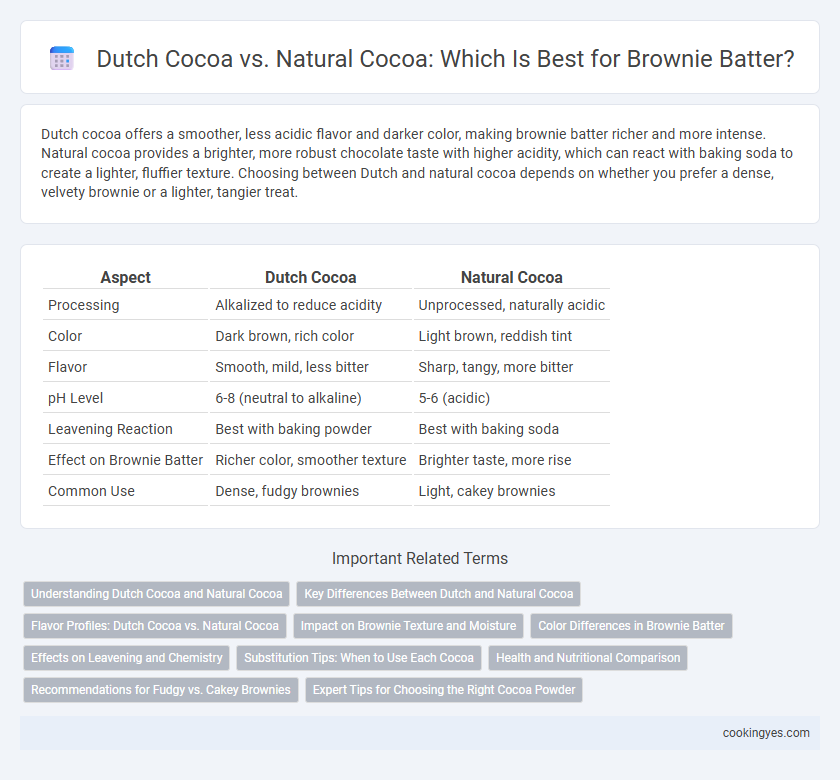Dutch cocoa offers a smoother, less acidic flavor and darker color, making brownie batter richer and more intense. Natural cocoa provides a brighter, more robust chocolate taste with higher acidity, which can react with baking soda to create a lighter, fluffier texture. Choosing between Dutch and natural cocoa depends on whether you prefer a dense, velvety brownie or a lighter, tangier treat.
Table of Comparison
| Aspect | Dutch Cocoa | Natural Cocoa |
|---|---|---|
| Processing | Alkalized to reduce acidity | Unprocessed, naturally acidic |
| Color | Dark brown, rich color | Light brown, reddish tint |
| Flavor | Smooth, mild, less bitter | Sharp, tangy, more bitter |
| pH Level | 6-8 (neutral to alkaline) | 5-6 (acidic) |
| Leavening Reaction | Best with baking powder | Best with baking soda |
| Effect on Brownie Batter | Richer color, smoother texture | Brighter taste, more rise |
| Common Use | Dense, fudgy brownies | Light, cakey brownies |
Understanding Dutch Cocoa and Natural Cocoa
Dutch cocoa is alkalized to neutralize acidity, resulting in a smooth, mellow flavor and darker color ideal for rich, fudgy brownies. Natural cocoa retains its acidic properties with a sharper, more intense chocolate taste, which reacts with baking soda to create lift in lighter brownie batters. Choosing between Dutch and natural cocoa impacts the batter's pH, flavor profile, and texture, crucial for achieving the desired brownie consistency.
Key Differences Between Dutch and Natural Cocoa
Dutch cocoa is alkalized, resulting in a mild, smooth flavor and darker color, while natural cocoa is acidic with a robust, sharp taste and lighter hue. The pH difference affects leavening; natural cocoa reacts with baking soda to create rise, whereas Dutch cocoa requires baking powder for effective leavening. Brownie batter made with Dutch cocoa yields a richer, less tangy fudge-like texture compared to the more acidic and intensely chocolatey result from natural cocoa.
Flavor Profiles: Dutch Cocoa vs. Natural Cocoa
Dutch cocoa offers a smoother, milder chocolate flavor with reduced acidity, enhancing the rich and velvety texture of brownie batter. Natural cocoa delivers a more intense, sharp, and slightly fruity taste due to its higher acidity, lending a classic chocolate tang to baked goods. Choosing between Dutch and natural cocoa significantly influences the brownie's depth of flavor and overall taste profile.
Impact on Brownie Texture and Moisture
Dutch cocoa, being alkalized and less acidic, imparts a smoother, darker color and a more mellow chocolate flavor to brownie batter, often resulting in a fudgier and moist texture due to its lowered cocoa acidity. Natural cocoa, with its higher acidity and robust flavor, enhances the cocoa's sharpness and contributes to a lighter color and a slightly drier, cakier crumb in brownies. Choosing between Dutch and natural cocoa directly affects the balance of moisture retention and texture density in the final brownie product.
Color Differences in Brownie Batter
Dutch cocoa produces a darker, richer color in brownie batter due to its alkalized processing, which neutralizes acidity and deepens the hue. Natural cocoa powder retains its natural acidity, giving brownie batter a lighter, reddish-brown tone. The color difference significantly influences the visual appeal and perceived intensity of chocolate flavor in the final baked brownies.
Effects on Leavening and Chemistry
Dutch cocoa, treated with an alkalizing agent, has a neutral pH that slows down the leavening reaction by reducing the effectiveness of baking soda in brownie batter, resulting in a denser and fudgier texture. In contrast, natural cocoa powder is acidic, which activates baking soda and promotes leavening, creating a lighter and more tender crumb in brownies. The chemical differences between Dutch and natural cocoa influence the balance of acidity and alkalinity, directly affecting the rise and final texture of the baked brownies.
Substitution Tips: When to Use Each Cocoa
Dutch cocoa offers a smoother, less acidic flavor ideal for fudgy brownie batters, while natural cocoa provides a brighter, more intense chocolate taste suited for lighter, cakey brownies. Substitute Dutch cocoa when the recipe includes baking soda to balance acidity and achieve a rich color, whereas natural cocoa works best with recipes using baking powder, preserving the traditional tang. Adjust leavening agents accordingly to maintain the desired texture and flavor profile in your brownie batter.
Health and Nutritional Comparison
Dutch cocoa undergoes alkalization, which reduces acidity and imparts a milder flavor, while natural cocoa retains its acidic nature and stronger chocolate taste. Nutritionally, both types contain antioxidants, but natural cocoa preserves higher levels of polyphenols due to minimal processing, offering greater health benefits. Choosing natural cocoa for brownie batter can enhance antioxidant intake, whereas Dutch cocoa provides a smoother taste with slightly lower acidity, affecting digestion and overall flavor profile.
Recommendations for Fudgy vs. Cakey Brownies
Dutch cocoa offers a smooth, mellow flavor with a darker color, making it ideal for cakey brownies that benefit from its neutral acidity and enhanced chocolate depth. Natural cocoa contains a brighter, more acidic profile that reacts with baking soda to create a lighter, airier texture, perfect for fudgy brownies with pronounced chocolate tang. For dense, gooey brownies, natural cocoa is recommended, while Dutch cocoa suits recipes aiming for a softer, cake-like crumb.
Expert Tips for Choosing the Right Cocoa Powder
Dutch cocoa powder offers a mellow, rich flavor and darker color due to its alkalized processing, making it ideal for fudgy brownie batters. Natural cocoa powder provides a more intense, sharp chocolate taste and reacts with baking soda to create lift, suitable for cakier brownies. Experts recommend selecting based on desired texture and acidity balance to achieve perfect brownie consistency and taste.
Dutch Cocoa vs Natural Cocoa for Brownie Batter Infographic

 cookingyes.com
cookingyes.com